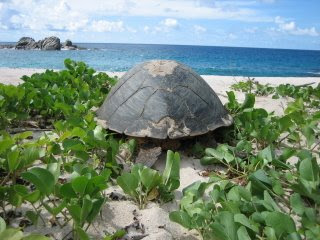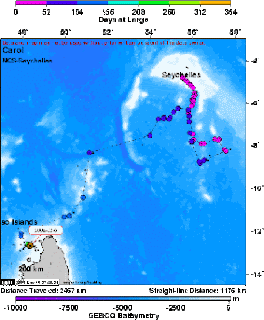Take for example the Green Turtle (Chelonia mydas). Green Turtles are herbivorous and feed on seagrass beds throughout the tropics. This species of turtle is often targeted for its meat, but also caught accidentally in commercial fisheries. Its nesting sites are often destroyed through coastal developments. The species, as with other turtle species, is listed as Endangered on the IUCN’s red list and if we do not take care soon there will be no wild turtles left for our grand children to enjoy.
So why are turtles important?
A young Green turtle in its foraging grounds, photo MCS-UK
Green Turtles are one of the few animals that eat sea grass and in are in fact considered keystone species in many areas, as they play a major role in determining the community structure essential in maintaining healthy seagrass beds. Like a normal grass lawn on land, seas grass beds need to be constantly cut short to keep healthy. Cropping by hungry Green turtles, allows the sea grass to spread across the sea floor rather than just getting longer and older grass blades. The fresh young leaves from cropped plants, have a high nutritional value and support a wide range of other smaller herbivorous animals, which are eaten by bigger carnivorous fish, which are in turn eaten by humans.
A healthy seagrass bed supporting many species of fish, shellfish and crustaceans, photo
As seagrass beds are vital breeding and nursery grounds for many species of fish, shellfish and crustaceans (many of which are commercially exploited), if these animals cannot breed successfully, and their young are unable to develop an mature, their populations will eventually decline.
Fresh fish from local markets, photo John Nevill
As the populations of commercial species decline, fishermen are unable to meet demand for fish, shellfish and crustaceans. People who rely on these as their staple diet either starve or may take to crime to make ends meet.
Tourism, is often a major source of income for many coastal communities, photo Elise Bromley
As many coastal areas also rely on tourism, when the crime rates go up, the tourist stay away leading to loss of jobs and even more hardship for coastal communities which eventually impact people living further inland.
Turtles have existed for over 100 million years, travelling unhindered throughout the world's oceans. Today, they are struggling to survive, mainly because of things people are doing to the oceans and beaches. It is possible that a world in which turtles continue to die in large numbers, may soon become a world in which humans struggle to survive.
If, however, we learn from our mistakes and begin changing our behavior, there is still time to save turtles from extinction. In the process, we will not only be saving one of the world’s most mysterious creatures, a survivor from the age of the dinosaurs, we might just be saving ourselves too!















